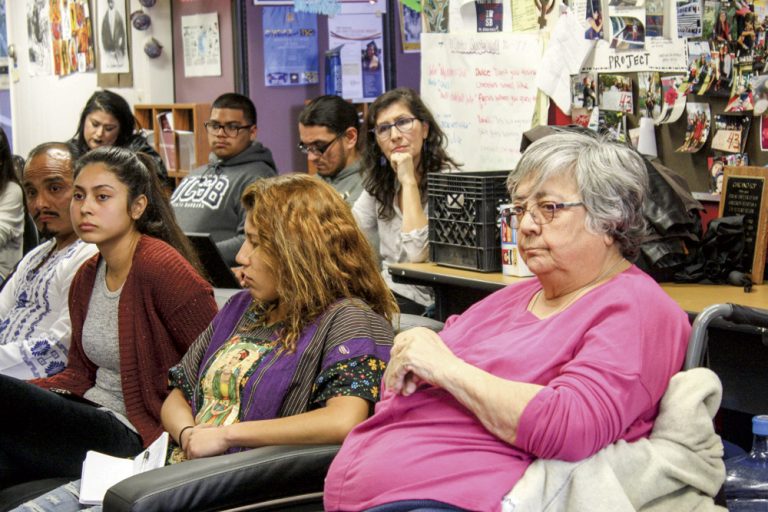
Madeleine Lee
Campus Beat Reporter
With the approval of Chancellor Henry Yang, University of California, Santa Barbara administrators have rescinded the 45-day vacate notice issued to occupants of El Centro to the relief of students, faculty, and alumni.
Administrators issued the 45-day vacate notice after structural consultants determined the extent of foundational dry rot to be a “severe” life safety risk, according to UC seismic code. The decision to revoke the notice is the result of nearly two weeks of ongoing negotiation between administration and representatives of the cultural organization El Congreso, whose student and alumni members have operated out of El Centro since the early 1970’s.
Support came from numerous campus departments, including the Chicano Studies faculty and Educational Opportunity Program counselors, whose offices were once housed in the building, as well as from the Associated Students Senate who passed a resolution in support of the the building’s permanence last week.
“Because of the students’ strong concerns about finishing the academic year,” said Chancellor Yang in an email response to concerned UCSB and El Congreso alumna Yolanda Marquez, “we are prepared to provide temporary shoring around the perimeter of the building until we can provide a permanent fix.”
At the most recent meeting, held Friday afternoon, campus architect Marc Fisher elaborated on the “shoring” alluded to by Yang, describing it as “putting a belt around the building” in order to temporarily ensure its stability in the case of an earthquake. The temporary fix will be implemented as soon as possible, while permanent construction will begin mid-June following spring quarter commencement as requested by students in an earlier meeting.
“In this way, we can ensure the least interruption to students as possible and allow for the building to ideally be online by fall quarter of 2017,” said Fisher.
Communication between both channels will continue throughout the year as administration plans on weekly meetings with students every Friday. Administrators will confirm plans for the permanent construction phase in the coming weeks.
“We are committed to replicating El Centro exactly as it stands originally,” Yang wrote in an email statement, “and preserving its cultural legacy so that it continues to be a cornerstone for our campus and community.”
This is not the first time the building’s permanence has been questioned. According to library archives, administrators attempted to relocate Chicano Studies and EOP offices to building 477 between 1983 and 1985, and it was again considered briefly in 1987. Students protested the move after demands could not be met, arguing instead that services would be better utilized if all under the same roof. The Chicano Studies department and EOP offices moved in later years after expansion of both departments necessitated more space.
For decades, both the building of El Centro and its umbrella programs—the Chicano Studies Institute, the Department of Chicano Studies, El Congreso, and the library’s
Colección Tloque Nahuaque—have provided support and built identity for Latinx students.
Of the hundreds of students that use the space, fourth year biology major Yaneli Gutierrez is perhaps the one who feels most at home. At Friday’s meeting, she sat in the center of administrators and fellow El Congreso members, cross-legged and casual, her feet bare and her shoes placed neatly beside her.
“My mother, my father, my uncle, my aunt, my aunt’s sister, my godparents—they all helped make this space,” said Gutierrez after Friday’s meeting. She sat steps away from a mural painted and signed by her uncle, Abel Gutierrez, who chaired El Congreso during the 1994 hunger strike. “The only reason why I’m here is because of this building and because of what it stands for.”
Though UCSB is now a Hispanic Serving Institution with approximately 27 percent students Latinx, Gutierrez’s family relied on El Centro in the late 80s and early 90s when the Latinx population was far smaller. Latinx students comprised only 11 percent of the population by the time of Chancellor Yang’s appointment in 1994.
“El Centro has always been a place for organizing, a place for solace, a place where we can come to talk about how to combat discrimination,” said Gutierrez.
The stories she remembers most vividly from her father and uncle are those from the hunger strike of 1994. El Congreso members fasted for well over a week to protest a hostile campus environment and the university’s refusal to hire additional Chicano Studies faculty and professors of color. Gutierrez recalled a story in which one fraternity ordered pizza to the protesters and ate in front of them.
Echoing those sentiments, Marquez, who participated alongside hunger strikers and knew Gutierrez’s father, emphasized the history of struggle and triumph that the building represents.
“This building has gone through a fight that you cannot imagine—a history you cannot imagine,” said Marquez. She pointed to the four walls covered in student paintings and protest propaganda, each painted a different color—white for elders, red for children, black for women, yellow for warriors. “There was too much fought for with the building to have it all done away with.”
As construction for the temporary building fix begins, student groups will continue to use the space for activism and planning purposes. El Congreso, along with M.U.J.E.R., are planning their annual outreach programs and conferences that together recruit hundreds of future undergraduates.










